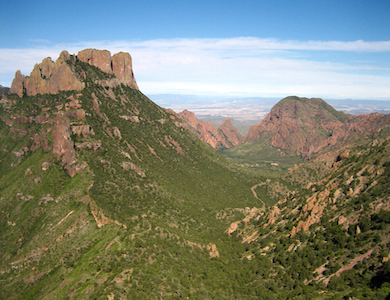
As fracking continues to spread to new areas of Texas, local citizens are concerned about its environmental impact and the effect it has on the small town way of life. Big Bend area Sierran Kay Plavidal gives a moving account of how Big Bend/Alpine could soon be on the verge of losing its beauty, uniqueness, and endangering its water supplies. But citizens are organizing themselves.
By Kay Plavidal, Big Bend Sierra Club
The Big Bend. Unique. Remote. Desolate. Loved for its wide-open spaces, unobstructed vistas and dark night skies. But that could all change if energy companies find what they're looking for.
According to the U.S. Energy Information Administration, two "shale plays" are located smack dab in the heart of Big Bend. Another is just south of the border around Ojinaga. "Shale play" means "fracking." There is no other way to recover gas from shale.
Production from the prolific Barnett Shale play in the Fort Worth area has comprised up to 70 percent of all U.S. shale-gas production. Geologists expect to find Barnett Shale in the Marfa Basin as well. Three exploratory wells are being drilled there: two located 19 miles southeast of Marfa and one 25 miles south of Alpine.
The Delaware Basin, which extends from Alpine to Carlsbad, contains several potential shale-gas units. Concho Resources, Inc. has identified 10,600 drilling locations in the basin. Two exploratory wells are being drilled 30 miles north of Alpine. Others have been drilled in Reeves County near Balmorhea State Park and the world's largest spring-fed pool.
Around Ojinaga, Petroleos Mexicanos (Pemex) has drilled 29 wells and begun producing gas from the Eagle Ford – an established shale-gas play in South Texas. Mexico plans to double its natural gas production by 2025 and build pipelines to transport fracked gas. Two proposed pipelines would cross the Big Bend, one possibly running between Alpine and Marfa.
Water
A comprehensive list of the negative impacts of fracking would take up too much space in this article. But the threat it poses to drinking water supplies should keep every Big Bend resident awake at night.
Fracking can use several million gallons of water per well; and because that water emerges from the fracking process as a toxic, contaminated liquid, it must be disposed of in a way that effectively removes it from the water cycle forever. The common disposal method is deep-well injection – drilling a "disposal" well and injecting the toxic wastewater deep into the ground, where (we hope) it stays forever. Scientists have linked earthquakes to disposal wells.
Of course, the concern is that this chemical-laced water will make its way into drinking water aquifers either during the fracking process or later, during disposal. Once an aquifer is polluted with this stuff, it is done as a source of drinking water.
Here in the Chihuahuan Desert, annual rainfall ranges from 10 to 14 inches. Climate models predict warmer temperatures and less rain for the region. Therefore, preserving and protecting water supplies is paramount.
Quality of Life
Water concerns aside, citizens of the Big Bend fear that our utopian, small-town way of life will be destroyed in much the same way as the towns of Big Lake, Big Spring, Carlsbad and Pecos have been. While tabling at Farm Stand Marfa, I spoke with a couple from Pecos who said, "Oh, Pecos is already gone. We don't drink the water there." A long-time resident of Reeves County told me that she was going to change hairdressers because she can no longer face the truck traffic around Midland-Odessa.
Most Big Bend residents don't want the same thing to happen here. They don't want their town to become just another shale boomtown, with high crime rates, mega-truck traffic, noise and light pollution. That's not why they live here. That’s not why visitors come here.
Citizens Take Notice
It began in Alpine. A handful of Sierrans met at the Railroad Blues Bar on May 23 and created a plan that focused on two things: educational outreach and a ban on fracking in Alpine.
Thus far, our work has focused on Alpine. For three consecutive Mondays in July, volunteers met to: a) craft a mission statement and goals, b) identify and disseminate tasks for research on everything from water laws and aquifers to gas pipelines, and c) plan outreach activities.
Primarily through tabling at local farmer's markets, reaching out to other Sierra Club members, and offering free screenings of the movie Gasland Part 2 accompanied by Q&A sessions, we've built a base of actively committed volunteers, a listserv, and a Facebook page with a growing membership.
At the July 1 Alpine City Council meeting, we presented information about fracking. Approximately 80 citizens attended and most of those who chose to speak supported an ordinance banning fracking. We hope to bring the ordinance up for an official debate and vote in August or early September.
Also this month, a group of Marfans met for the first time to discuss fracking and water issues. We will support this new group by sharing information and experience. Through outreach to each population centers in the tri-county region – Terlingua, Fort Davis, Marathon and Presidio – we hope to spur the formation of similar local groups.
However, much of the Big Bend consists of large tracts of acreage owned by ranchers or investors. These are the folks that energy companies are targeting; their land is where most of the drilling will take place. In fact, energy companies have already leased approximately 135,000 acres, dating back to 2006. We are recruiting volunteers who know or have worked with ranchers and landowners to find common ground. We hope to convince these landowners that the risks associated with fracking are too great and too permanent, and that it is in their best interests as land stewards and ranchers to keep shale-gas production out of the Big Bend. We simply cannot win without them.